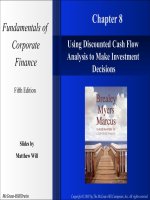Fundamentals of corporate finance 10e ROSS JORDAN chap014
Bạn đang xem bản rút gọn của tài liệu. Xem và tải ngay bản đầy đủ của tài liệu tại đây (1.41 MB, 79 trang )
Chapter
14
Cost of Capital
14-1
McGraw-Hill/Irwin
Copyright © 2013 by The McGraw-Hill Companies, Inc. All rights reserved.
Chapter Outline
• The Cost of Capital – Overview
• The Cost of Equity
• The Cost of Debt
• The Cost of Preferred Stock
• The Weighted Average Cost of Capital
(WACC)
• Divisional and Project Costs of Capital
• Floatation Costs relative to WACC
14-2
Chapter Outline
• The Cost of Capital – Overview
• The Cost of Equity
• The Cost of Debt
• The Cost of Preferred Stock
• The Weighted Average Cost of Capital
(WACC)
• Divisional and Project Costs of Capital
• Floatation Costs relative to WACC
14-3
Why the Cost of Capital
Is Important
1. We know that the return earned on assets
depends on the risk of those assets
2. The return to an investor is the same as
the cost to the company
14-4
Why the Cost of Capital
Is Important
3. Our cost of capital provides us with an
indication of how the market views the
risk of our assets
4. Knowing our cost of capital can also help
us determine our required return for
capital budgeting projects
14-5
Chapter Outline
• The Cost of Capital – Overview
• The Cost of Equity
• The Cost of Debt
• The Cost of Preferred Stock
• The Weighted Average Cost of Capital
(WACC)
• Divisional and Project Costs of Capital
• Floatation Costs relative to WACC
14-6
The Cost of Equity
The cost of equity is the return required by
equity investors given the risk of the cash
flows from the firm:
•Business risk
•Financial risk
14-7
The Cost of Equity
There are two major methods for
determining the cost of equity:
1. Dividend growth model
(aka: the Gordon
Model)
14-8
2. SML, or the CAPM
The Dividend Growth
Model
(The Gordon Model)
Start with the dividend growth model formula
and rearrange to solve for RE
D1
P0 =
RE − g
D1
RE =
+g
P0
14-9
Dividend Growth Model
Example
Suppose that your company is expected to pay a
dividend of $1.50 per share next year.
There has been a steady growth in dividends of
5.1% per year and the market expects that to
continue. The current price is $25.
What is the cost of equity?
14-10
1.50
RE =
+ .051 = .111 = 11.1%
25
Example: Estimating the
Dividend Growth Rate
One method for estimating the growth rate is
to use the historical average:
Year
2005
2006
2007
2008
2009
Dividend Percent Change
1.23
(1.30 – 1.23) / 1.23 = 5.7%
1.30
(1.36 – 1.30) / 1.30 = 4.6%
1.36
(1.43 – 1.36) / 1.36 = 5.1%
1.43
(1.50 – 1.43) / 1.43 = 4.9%
1.50
Average = (5.7 + 4.6 + 5.1 + 4.9) / 4 = 5.1%
14-11
Advantages and
Disadvantages of the
Dividend Growth Model
Advantage:
Easy to understand and
use
14-12
Advantages and
Disadvantages of the
Dividend Growth Model
• Disadvantages:
• Only applicable to
companies currently
paying dividends
• Not applicable if dividends
aren’t growing at a
reasonably constant rate
14-13
Advantages and
Disadvantages of the
Dividend Growth Model
• Disadvantages :
• Extremely sensitive to
the estimated growth
rate – an increase in g of
1% increases the cost of
equity by 1%
• Does not explicitly
consider risk
14-14
The SML Approach
Use the following information to
compute our cost of equity:
Risk-free rate, Rf
Market risk premium, E(RM) – Rf
Systematic risk of asset, β
RE = R f + β E ( E ( RM ) − R f )
14-15
Example - SML
Suppose your company has:
• an equity beta of .58
• the current risk-free rate is 6.1%
• the expected market risk premium is
8.6%is the cost of equity using the SML
What
valuation technique?
RE = 6.1 + .58(8.6) = 11.1%
14-16
How Did We Do?
Since we came up with
similar numbers using
both the dividend growth
model (11.1%) and the
SML approach (11.1%),
we should feel good about
our estimate!
14-17
Advantages and
Disadvantages of SML
Advantages:
• Explicitly adjusts for systematic risk
• Applicable to all companies, as long
as we can estimate beta
14-18
Advantages and
Disadvantages of SML
Disadvantages:
• Have to estimate the expected market risk
premium, which does vary over time
• Have to estimate beta, which also varies
over time
• We are using the past to predict the future,
which is not always reliable
14-19
Example – Cost of Equity
Our company has a beta of 1.5.
The market risk premium is expected to be 9%, and the
current risk-free rate is 6%.
We have used analysts’ estimates to determine that the
market believes our dividends will grow at 6% per year
and our last dividend was $2.
Our stock is currently selling for $15.65.
What is our cost of equity using the SML?
RE = 6% + 1.5(9%) = 19.5%
14-20
Example – Cost of Equity
Our company has a beta of 1.5.
The market risk premium is expected to be 9%, and the
current risk-free rate is 6%.
We have used analysts’ estimates to determine that the
market believes our dividends will grow at 6% per year
and our last dividend was $2.
Our stock is currently selling for $15.65.
What is our cost of equity using the DGM?
RE= [2(1.06) / 15.65] + .06 = 19.55%
14-21
Chapter Outline
• The Cost of Capital – Overview
• The Cost of Equity
• The Cost of Debt
• The Cost of Preferred Stock
• The Weighted Average Cost of Capital
(WACC)
• Divisional and Project Costs of Capital
• Floatation Costs relative to WACC
14-22
Cost of Debt
The cost of debt is the required return
on our company’s debt
We usually focus on the cost of longterm debt or bonds (as opposed to
short-term debt like notes payable)
14-23
Cost of Debt
The required return is best estimated
by computing the yield-to-maturity
on the existing long-term debt (the
YTM).
The computation of the YTM was
presented in the chapter on Bond
Valuation
14-24
Example: Cost of Debt:
computing the YTM
Suppose we have a corporate bond issue
currently outstanding that has 25 years left to
maturity.
The coupon rate is 9%, and coupons are paid
semiannually.
The bond is currently selling for $908.72 per
$1,000 bond.
What is the cost of debt?
14-25









